 Using search engines has become the second most popular activity for Web users, according to new research from the Pew Internet & American Life Project.
Using search engines has become the second most popular activity for Web users, according to new research from the Pew Internet & American Life Project.
The figures put search engines second only to email as the numero uno Net application, with reading the news registering as the third most popular Web activity.
The research reveals that an average 41 per cent of Web-connected Americans use search engines on a typical day, a sharp 55 percent rise from the middle of 2004.
In numbers, this equates to a jump from 38 million daily search engine users in June 2004 to around 59 million users in September, 2005.
As expected, email remains the Web’s major attraction, with 52 per cent of Americans checking mail on any given day, up 45 per cent from June last year.
The Pew project looked into the demographics of Web users and discovered that those spending the most time on search engines tended to be in their 30s and well-off.
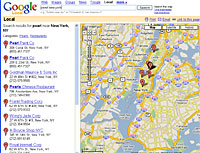 ‘Gen X’ surfers (29-40 year olds, not the Billy Idol-fronted band) were online the most (51 per cent), followed by ‘Gen Y’ users (18-28 year olds), ‘Older Baby Boomers’ (51-59 yrs old), ‘Younger Baby Boomers’ (41-50), ‘Matures’ (60-69) and, finally ‘After work’ (70+). We wonder who makes up these daft categories?
‘Gen X’ surfers (29-40 year olds, not the Billy Idol-fronted band) were online the most (51 per cent), followed by ‘Gen Y’ users (18-28 year olds), ‘Older Baby Boomers’ (51-59 yrs old), ‘Younger Baby Boomers’ (41-50), ‘Matures’ (60-69) and, finally ‘After work’ (70+). We wonder who makes up these daft categories?
The report commented, “Those who use search engines on an average day tend to be heavy Internet users. They are much more likely to have broadband connections than dial-up connections; to log on to the Internet several times a day; and to have spent considerable time online during the day.”
With Google recently claiming to have trebled its index of 8bn pages and Yahoo! claiming 19.2bn pages, it’s not surprising that the search engines are getting a hammering.
What is interesting, however, is the rise in people searching using ‘local’ qualifiers, like postcodes or addresses, to narrow down their search results.
Google still rules supreme as the king of the Web search tools, registering 43.7 per cent of local searches, with Yahoo! lording it over Internet Yellow Page search sites (where users type in data such as location and business type) with 27.6 per cent of searches.
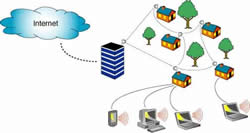 Mesh Networks are going to grow enormously by the end of the decade, according to ABI research. This ‘revalation’ is following years technical-types raving on about them.
Mesh Networks are going to grow enormously by the end of the decade, according to ABI research. This ‘revalation’ is following years technical-types raving on about them. BPI, the UK record label industry association has released its third-quarter report revealing that it’s boom time for the Brit digital music industry.
BPI, the UK record label industry association has released its third-quarter report revealing that it’s boom time for the Brit digital music industry. Digital is also claiming a bigger share of the Top 75 singles chart, growing from 15.9 percent when the combined chart launched in mid-April to 25.5 percent at the end of August.
Digital is also claiming a bigger share of the Top 75 singles chart, growing from 15.9 percent when the combined chart launched in mid-April to 25.5 percent at the end of August. Once again, the death of vinyl has been exaggerated with the 7-inch physical singles market registering 80 per cent growth with 800,000 sales.
Once again, the death of vinyl has been exaggerated with the 7-inch physical singles market registering 80 per cent growth with 800,000 sales. “While the record label model of investing in the best new music talent remains the same, the emergence of innovative new digital services means that the record companies can offer consumers even greater choice as to how to access their music.”
“While the record label model of investing in the best new music talent remains the same, the emergence of innovative new digital services means that the record companies can offer consumers even greater choice as to how to access their music.” A new study has revealed that one in five Americans is without home Internet access and have never been online, potentially hindering their access to crucial information and services.
A new study has revealed that one in five Americans is without home Internet access and have never been online, potentially hindering their access to crucial information and services. Not surprisingly, the study also found that people with lower incomes and less education also registered lower percentages of Internet adoption.
Not surprisingly, the study also found that people with lower incomes and less education also registered lower percentages of Internet adoption.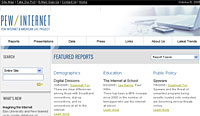 Broadband makes it easier for surfers to whiz around the Web and download music, view videos, enjoy free VoIP calls and access online services and important information on topics like health and finance.
Broadband makes it easier for surfers to whiz around the Web and download music, view videos, enjoy free VoIP calls and access online services and important information on topics like health and finance. The UK market for online shopping looks set to soar to £60 billion (~€88 billion, US$108 billion~) by 2010 according to a new report.
The UK market for online shopping looks set to soar to £60 billion (~€88 billion, US$108 billion~) by 2010 according to a new report.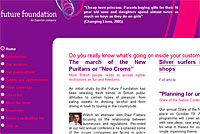 The Future Foundation commented that websites sporting yoof-orientated design, teensy weensy text and kray-zee interfaces are likely to miss out on silver surfer sales.
The Future Foundation commented that websites sporting yoof-orientated design, teensy weensy text and kray-zee interfaces are likely to miss out on silver surfer sales. New US research claims that Americans are becoming increasingly “digital,” with over three quarters owning computers and many households verily humming with multiple digital electronics products, including cell phones to entertainment devices to cameras.
New US research claims that Americans are becoming increasingly “digital,” with over three quarters owning computers and many households verily humming with multiple digital electronics products, including cell phones to entertainment devices to cameras. The research was commissioned by hard drive manufacturer, Seagate, who were keen to remind users of their role in the digital revolution:
The research was commissioned by hard drive manufacturer, Seagate, who were keen to remind users of their role in the digital revolution: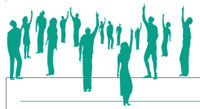 Illegal music downloaders shell out more for legitimate music downloads than goody two-shoes music fans.
Illegal music downloaders shell out more for legitimate music downloads than goody two-shoes music fans.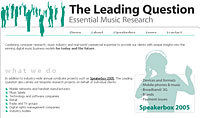 How much both groups spend on CDs wasn’t specified.
How much both groups spend on CDs wasn’t specified.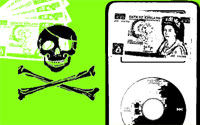 Respondents cited built-in cameras, organiser functions and video cameras above music players in their preferences for mobile phone features.
Respondents cited built-in cameras, organiser functions and video cameras above music players in their preferences for mobile phone features. Microsoft has launched the first public beta of its Virtual Earth, an online mapping application overlaying satellite images with local searches and maps.
Microsoft has launched the first public beta of its Virtual Earth, an online mapping application overlaying satellite images with local searches and maps.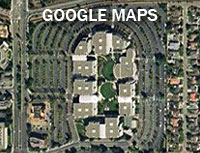 Virtual Earth will also have the capability to visually point out locations for ATMs, restaurants, and petrol stations – something that the rival Google Maps service has been able to do since incorporating satellite imagery in April this year.
Virtual Earth will also have the capability to visually point out locations for ATMs, restaurants, and petrol stations – something that the rival Google Maps service has been able to do since incorporating satellite imagery in April this year.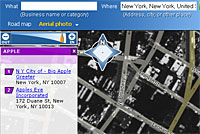 Mac users, however, will have to wait until autumn for a version that runs on their machines.
Mac users, however, will have to wait until autumn for a version that runs on their machines.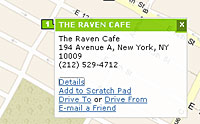 Wags on the Internet are claiming that Microsoft has virtually wiped Apple off the face of the Web, noting that Apple’s Silicon Valley headquarters – which can be seen in their full glory on Google Maps – appears as nothing more than a deserted parking lot in Virtual Earth.
Wags on the Internet are claiming that Microsoft has virtually wiped Apple off the face of the Web, noting that Apple’s Silicon Valley headquarters – which can be seen in their full glory on Google Maps – appears as nothing more than a deserted parking lot in Virtual Earth. Hefty prices and consumer-baffling technology continues to hold back the development and adoption of space age converged digital home solutions, according to a survey by Accenture.
Hefty prices and consumer-baffling technology continues to hold back the development and adoption of space age converged digital home solutions, according to a survey by Accenture. “In order to truly meet consumer needs, stronger collaboration and partnerships among hardware, content and service companies is imperative,” he added.
“In order to truly meet consumer needs, stronger collaboration and partnerships among hardware, content and service companies is imperative,” he added. But it’s not all doom and gloom, with consumers expressing a willingness to pay additional fees each month for services designed to enhance ease of use and convenience.
But it’s not all doom and gloom, with consumers expressing a willingness to pay additional fees each month for services designed to enhance ease of use and convenience. The UK record industry trade association the BPI has revealed that download sales in 2005 have raced past the ten-million mark – almost twice the amount for the whole of 2004.
The UK record industry trade association the BPI has revealed that download sales in 2005 have raced past the ten-million mark – almost twice the amount for the whole of 2004.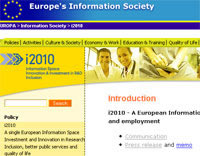 Illegal music downloads remain a thorn in the side of the industry, but the growth in legal downloads now outstrips the growth in dodgy file sharing with Jamieson adding, “The battle against illegal files-haring will continue, but we are delighted to have hit this milestone so soon”.
Illegal music downloads remain a thorn in the side of the industry, but the growth in legal downloads now outstrips the growth in dodgy file sharing with Jamieson adding, “The battle against illegal files-haring will continue, but we are delighted to have hit this milestone so soon”.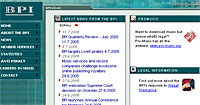 The resurgence of vinyl has been attributed to British indie and rock acts love affair with their near ancient format, with bands like Iron Maiden’s, Libertines, Babyshambles, Kaiser Chiefs and Franz Ferdinand all releasing songs on vinyl.
The resurgence of vinyl has been attributed to British indie and rock acts love affair with their near ancient format, with bands like Iron Maiden’s, Libertines, Babyshambles, Kaiser Chiefs and Franz Ferdinand all releasing songs on vinyl.